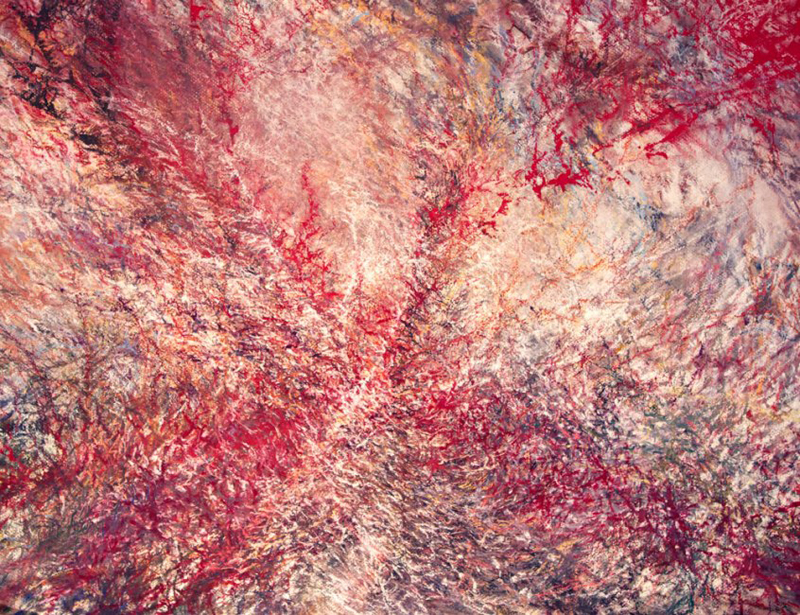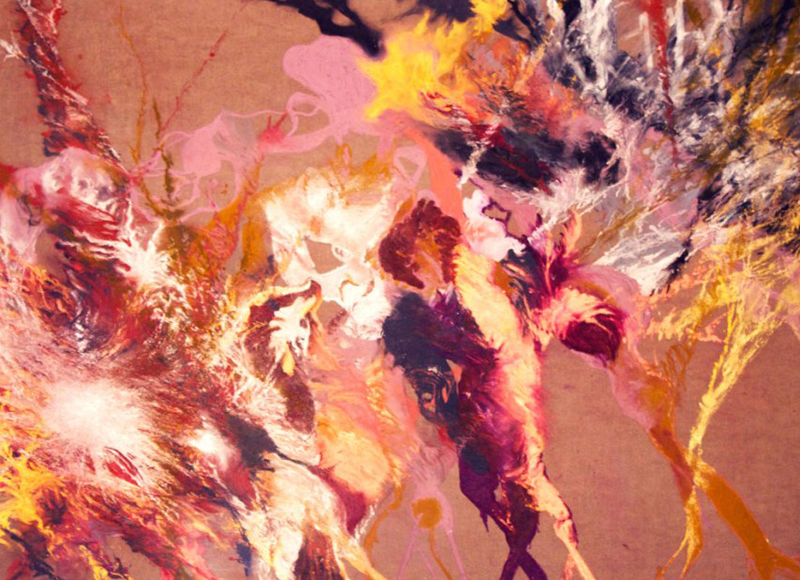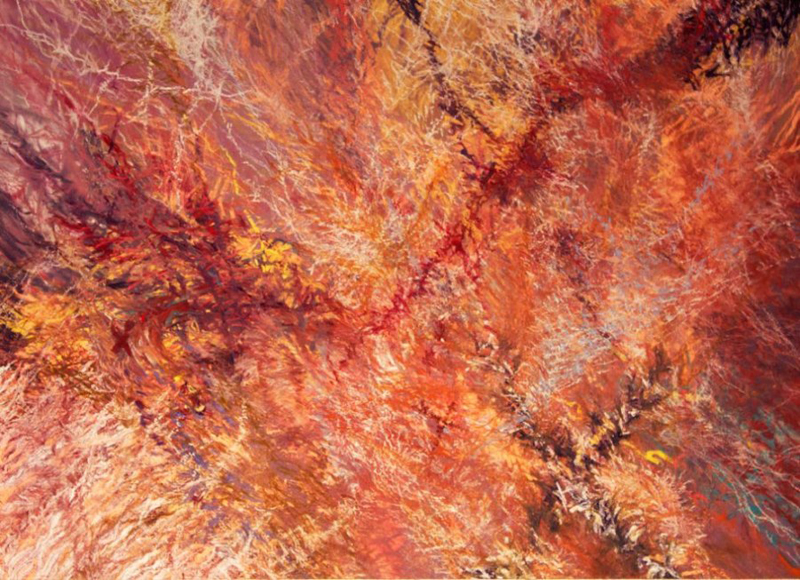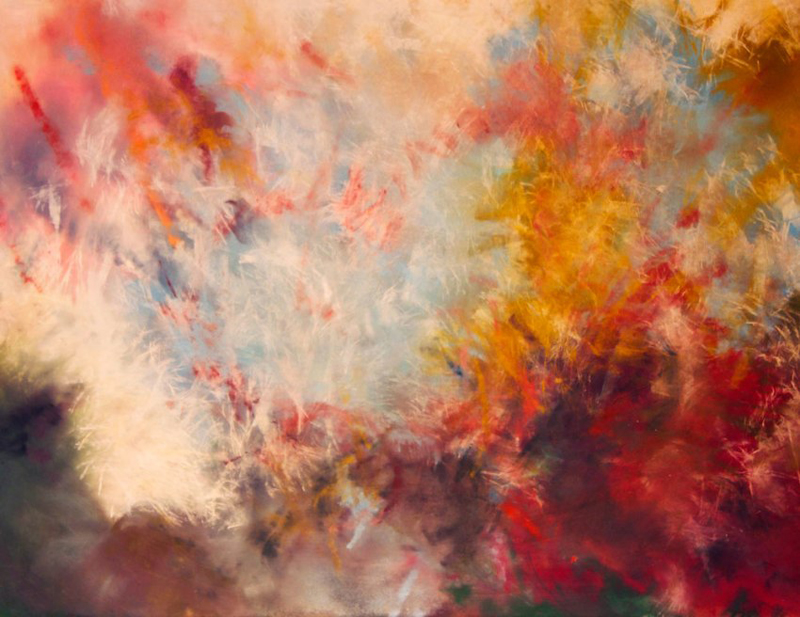
Photograph: © Laurie Stern
Painting as a means to healing
Laurie Stern has been a “closet artist” since age three, making drawings and paintings as a private matter; only now intending to show her work publicly. Art has played various roles in her life but doing it is always an act of love. In recent years, she has added singing to painting; she takes voice lessons and sings at “open mic” sessions in local cafés in New Jersey. She has a Bachelor’s degree in Fine Arts and Master of Science degrees in Special Education and Clinical Social Work.
Laurie has worked professionally as an art facilitator in a therapeutic community for addiction treatment, teaching people in recovery how to use expressionistic painting to work through feelings. She has also used art media in her work as a special education teacher in New York City elementary and preschools. For the past 19 years, she has been working as a social worker and psychotherapist and has used art with clients at times to facilitate talk therapy. Laurie meditates and loves going on retreats, travelling, reading and taking very long walks, both urban and rural. She grew up in a New York City neighbourhood and lived in New York for many years as an adult before moving to Monroe Township, New Jersey, when she married and joined her husband in raising his two children.
In this week’s guest post for The Culturium, Laurie describes how, after being diagnosed with a potentially life-threatening illness, a subsequent trip to Arunachala, Tiruvannamalai, India, brought her deeply in touch with the “living satsang” that is the holy mountain, expressed through a stunning sequence of abstract art.
How my art expresses spirituality
ALWAYS DRAWN TO abstract art, I have watched my own artwork evolve since childhood from figurative to ambiguous, organic, emotional and sensory abstractions. Some of it shows linear networks hinting at body parts and blood systems; or, just as easily, hints at plants, tree branches and root systems. Some of it suggests energy currents and smoky, steamy or cloudy atmospheres. I hope my work suggests aspects of nature as interchangeable, all of the same essence—formlessness evidenced through form.
Doing artwork, often accompanied and inspired by music, leads me to a kind of meditation in which I “witness” arising emotions. This is art therapy as well as meditation. It’s also prayer because it invokes reverence for the Ineffable. (I also sing, sometimes even while I paint. To me, singing, like painting, feels meditative, heart-opening, letting go into a flow.)
I do not approach a painting with a plan for an image that I am trying to depict. I approach the blank surface without knowing where and how I will start or where and how I will finish. Sometimes it feels as though the painting paints itself. No mistakes are possible in this process.
And even when my painting process feels deliberate, I know that something deeper is running the show—the psychological unconscious at one level, the Mystery at the deepest level.
My paintings interconnect harmonious with dissonant and ironic visual elements. With each apparently dissonant element in the picture, I am drawn deeper into myself in a meditative way, and I discover how that element is integral to creating the whole. This meditation overrides any of my mind’s preconceived notions of how a so-called dissonant element should be “fixed”. Instead, I allow it to “be” and then paint in a way that lets it evolve and “fit in”. The result is a togetherness of all the elements in the picture, great and small, harmonious and dissonant, that express a unified wholeness.

Photograph: © Laurie Stern
What pointed me to nonduality
In May 2007, two days after my husband and I had travelled halfway around the world to Australia, by chance I discovered a lump in my breast. The next day I had a biopsy and the day after that I got the diagnosis of breast cancer. I was stunned. It seemed unbelievable that this was happening. In shock and fear, I wanted to go home right away and see a surgeon. But the soonest appointment I was able to get was two weeks away and the doctor advised me to stay in Australia and “enjoy your trip”. I didn’t think it would be possible to enjoy the trip with a cancer diagnosis hanging over my head. But that’s when something remarkable happened: I somehow became able to screen out problematic thoughts about the future.
Although visceral fear would come and go, I stopped “what-if” thinking about prognostic possibilities, particularly the “I could die” scenario. Graced in this way, anchored in the here and now, I experienced the beauty of Australia vividly and with a sense of wonder. Accordingly, a large, tender bruise on my chest, a reminder of where the biopsy needle had missed its mark, was accepted with equanimity. Although I didn’t know it at the time, I was learning to connect with a stillness beneath the turmoil.
When we returned home, I had surgery. Afterwards, during months of chemotherapy, weeks of radiation, and for many years afterwards, I delved into nonduality teachings through reading, meditating and attendance at numerous satsangs and retreats.
I am very grateful to be alive and well now, ten-plus years since discovering that tumour. While cancer was an experience I hope I never have to repeat, it became my starting point on a steep learning curve. I am indeed very grateful for that.

Photograph: © Laurie Stern
My Arunachala painting
My husband and I travelled to Tiruvannamalai, India, over New Year’s 2009, about a year and a half after we began exploring nonduality teachings in general, and Advaita in particular. We went there with a spiritual teacher and a small group. In Tiru, we meditated daily at Bhagavan Sri Ramana Maharshi’s ashram and had our own satsangs.
We also experienced an electrifying “teaching” on a morning hike to the top of Mount Arunachala with eight others and a guide. Ironically, or perhaps serendipitously, this teaching mirrored and reinforced insight I gained during the cancer episode. It began when we reached the top of the mountain in extreme tropical heat at high noon—and realized that we had run out of water.
There, our group dispersed. The guide, too, had gone. Already over-heated and tired, my husband and I headed down the mountain on our own. The trip down took us about two hours in direct sunlight, with no trees to provide shade. Large swathes were steep, slippery, granite surfaces.
Within a half-hour, my knees shook from exhaustion, I felt light-headed and my mouth was parched. There were no other hikers in sight; no one to call to if we needed help.
When I had the thought that we could pass out from sunstroke, I became frightened. But instead of panicking, I remained still within and witnessed the fear. As my body sensations ran their course without resistance, I became intensely focused on navigating down the mountain.
Finally, we came to Ramana’s meditation cave, and next to it, a small waterfall. While the water wasn’t safe for us Westerners to drink, we stood under the waterfall to cool off and rested briefly in the shelter of the cave. This might have saved us from passing out; and from there, it wasn’t that much farther to the bottom of the mountain.
Here, I will exercise some poetic licence: I stopped resisting the form of each moment-by-moment and observed how nature took care of us. I recognized that we were part of the flow, the nature of things. Mount Arunachala was an apt place to have made that observation!
When I returned home from Tiru, I wanted to paint my holistic experience of the living “satsang” I had while heading down the mountain. Through a painting process that entailed three years of starts and stops, the painting I made reconnected me with the stillness beneath turmoil I felt on that hike. Ideally, the essence of this experience will translate intuitively through the painting to viewers.

Photograph: © Laurie Stern
Post Notes
- Laurie Stern’s website
- Rashid Maxwell: To Save the Planet With a Paintbrush
- Wassily Kandinsky: Concerning the Spiritual in Art
- Paul Cézanne: La Montagne Sainte-Victoire
- Agnes Martin: Writings
- Guy Laramée: Fraîcheur
- Patrick Howe: Post Personalism in Art
